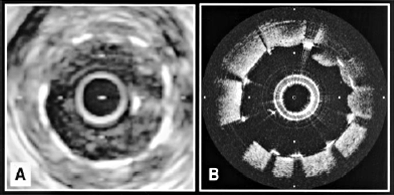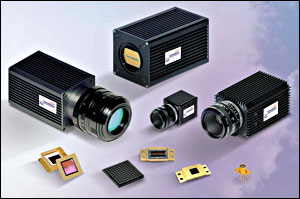
SD-OCT Could Help Nip Cancer in the Bud
Kipp Lynch, PhD
PRINCETON, N.J., March 16, 2007 -- Spectral domain optical coherence tomography (SD–OCT) in human tissue is demonstrating exciting capability to detect precancerous changes to cells years before tumors develop. SD-OCT can probe 3 mm into tissue -- skin, throat, colon or cardiovascular -- with microscope resolution of 10 µm. Doug Malchow, manager of commercial business development at Princeton, N.J.-based Sensors Unlimited Inc. (SUI), contrasts this technique to his early school days.
“I remember the dramatic images in high-school biology when you took a stained tissue histology slide and looked at it under the microscope to see, for example, the sweat glands,” said Malchow. “But in that case, you used a razor blade and took a shaving off a piece of tissue. Now it’s noninvasive, nondestructive, with amazing resolution -- talk about imaging magic, it’s just great.”

Images of a stented right coronary taken with (A) intravenous ultrasound and (B) OCT (Images: SUI)
The shortwave infrared (SWIR) wavelength of 1310 nm is valuable in looking at tissues, because it is the longest wavelength that can be transmitted through the tissue with the least amount of scatter by the size of the molecules. Longer wavelengths are absorbed by the high water content in the tissue, while shorter wavelengths won’t penetrate as deeply. SUI, part of Goodrich Corp., develops high-resolution SWIR cameras and detector arrays based on indium gallium arsenide (InGaAs) technology. The 16-year-old company has developed 1024 element linear arrays that are used to simultaneously capture all of the wavelengths of an interferogram generated by a broadband superluminescent LED. This greatly improves the image acquisition time over single-point detectors.
Malchow said the SD-OCT application is so important that SUI invested internal funds to develop a new linear array readout and camera to increase the acquisition rate tenfold.
“For us, the people in OCT who are using our products are generally the researchers. Right now, there is face-off between a scanning fast-tunable laser approach to OCT versus a linear array capture of the interference pattern,” said Malchow. “We’ve had a design that limited the speed of our 1024 array, and we’re addressing that. These new cameras will be in production this summer (2007) to assist in the development of this life-saving technology.”

SUI’s shortwave infrared cameras
One technological problem that OCT resolves is the speed of data acquisition. In practical terms, it’s difficult for a patient to sit still for a long period.
“In the linear array case, one line time of the linear-array-capturing, white-light interfered ray is essentially one data point,” said Malchow. “Take, for example, Barret’s syndrome, where the bottom of the throat starts to erode, turning into stomach lining material. It is a potential precursor, if it goes untreated, to a cancerous situation. So there is a strong interest in endoscopy. You need to profile the throat. So say, for the sake of argument, that it is one inch in diameter; that’s about a three-inch circumference, and you have to do four inches of that. That’s a lot of lines, and that’s where the speed of initial acquisition is an important factor, not to mention the number crunching and rebuilding it into an image.”
Malchow remains optimistic not only about early detection with noninvasive and nondestructive imaging techniques; he also envisions a time in the near future when these systems would be ubiquitous in clinics and hospitals. As opposed to an MRI -- a two-million-dollar machine sitting in a multimillion-dollar facility that is only affordable to a large community or as a shared resource -- OCT systems are affordable. Given limited health-care dollars, a $25,000 system is likely to be within the budget of most facilities, while $60,000 products require more justification and anything above $100,000 needs serious cost consideration.
“For example, Zeiss (Carl Zeiss Meditec Inc.) is shipping a large number of OCT retinal systems that are in the $65,000 range. When you consider that there are approximately 7500 hundred hospitals in the United States -- assuming that you have a medically compelling item -- you’re not going to sell a lot of million-dollar systems,” said Malchow. “But when the price is right and, more importantly, when a leading researcher stands up at a major medical conference and says, ‘If you’re not making this measurement, then you’re robbing your patients,’ then the floodgates open. We are beginning to see that in the optical coherence tomography industry, retinal scan OCT is mature and other applications will follow.”
But beyond cost, Malchow pointed out the greatest benefit of OCT: “The magic of OCT is that they’re talking about seeing precancerous cells five years before the cancer. If you can make OCT into a common screening device and have rapid clinical exploration of people with a precondition or family history, you can eliminate a lot of suffering by figuring out where the bad guys are and nipping them in the bud.”
For more information, visit: www.sensorsinc.com
/Buyers_Guide/Sensors_Unlimited_Inc/c14265